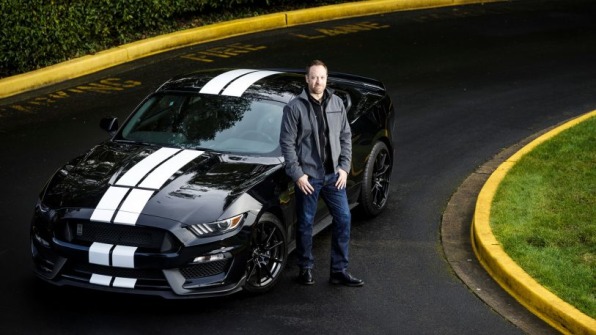
06 Oct The Untold Tale Of How Porsche’s Supercar Got Into Microsoft’s New Game
Just before revealing the Porsche 911 GT2 RS to the world, Dan Greenawalt had a crisis of confidence.
The creative director for Microsoft’s Turn 10 Studios had spent almost a year bringing Porsche’s latest supercar into Forza Motorsport 7, the latest installment in the venerable, hugely successful racing-game franchise for the Xbox. But until this moment in June, during the E3 gaming expo in Los Angeles, hardly anyone outside Porsche knew for sure that the GT2 existed. Even most of Greenawalt’s colleagues had been in the dark while Porsche and a handful of senior Turn 10 employees collaborated in secret. On stage at Microsoft’s Xbox press conference, Greenawalt wasn’t sure whether the gaming audience would appreciate what it was about to see.
“I’m a car guy,” Greenawalt says. “I know this Porsche 911 GT2 RS is, like, from another planet. It’s an incredible car. So I’ve got all the inside baseball knowledge, and I looked out on this crowd, and I’m like, ‘Are they going to get it? Are they going to understand that this is a history-changing moment, where an automotive industry has chosen to debut a premier supercar in front of a gaming industry–like a true merging of these two industries? Is this crowd going to get it?’”
If Greenawalt is exaggerating the implications, it’s only by a little. When Turn 10 Studios started working on the Forza series 15 years ago, the relationship between automotive and gaming industries was largely transactional. Auto makers would collect licensing fees for the rights to their cars’ names and likenesses, and they had final say over how their cars were presented, but otherwise they kept gaming at arms’ length.
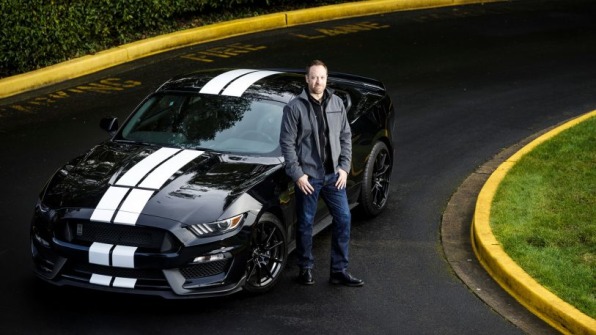
Over time, auto makers have started viewing racing games as more than just a source of licensing revenue. The Forza series has generated over $1 billion in retail sales, and is now played by 5 million people per month. For Porsche, Ford, Audi, and others, closer partnerships on games like Forza Motorsport 7–which launched on Xbox One and PC this week–are a prime opportunity to reach impressionable young minds.
Turn 10 has used that angle to get deeper into the car development process, gaining access to new vehicles before the public knows about them, and using what it learns to create more accurate simulations. But this in turn requires increasing degrees of care. Any leak of confidential information could provide a competitive advantage to rival auto makers, which would severely damage Turn 10’s relationship with the car companies it works with.
The Porsche 911 GT2 was Turn 10’s biggest secret yet. In interviews, both the auto maker and the studio described extreme measures to keep the project undercover.
“In the past, for different launches, we involved other partners,” says Sebastian Hornung, Porsche’s manager for branded entertainment. “But to have a partner that early, involved in revealing confidential information, that I believe is really unique.”
“Speed Dating” In Stuttgart
Until this year, the only way Turn 10 could get Porsche vehicles into its games was to sublicense the cars through Electronic Arts. Porsche had signed an exclusive licensing deal with the big game publisher for its Need for Speed series in 2000, and while that didn’t preclude Forza from offering Porsche cars, it did prevent the two companies from working on any deeper collaborations.
“It wasn’t really a true partnership,” says John Wendl, Turn 10’s director of content. “Now, because of that partnership, we’re able to do things we couldn’t in the past, and create these kinds of opportunities that just weren’t there before.”

In the spring of 2015, EA’s licensing deal was approaching expiration, so Turn 10 started talking to Porsche about ways to work together on Forza. Turn 10 gathered some high-level employees on both the business and content sides, and flew to Porsche’s headquarters in Stuttgart, Germany, for what Wendl describes as a two-day “speed dating” session.
“We spent quite a bit of time educating them on our products, our gamers, our audience, our history, and then they did the same, and walked us through their brand and product line,” Wendl says.
In mid-2016, Porsche got back in touch and acknowledged what auto blogs had been saying for months: The company was developing a new version of the 911 GT2, its flagship supercar that only comes around once every five to 10 years. Turn 10 weighed its options, and ultimately decided that the GT2 should be the “hero car” for Forza Motorsport 7, with its image on every box in the same way that a new NFL star poses for each year’s cover of Madden. Porsche and Turn 10 also agreed to announce the vehicle together.
“Porsche was excited to figure out how to insert automotive into the gaming world, and we came up together with the idea: Let’s take the biggest, baddest 911 ever, this new GT2 RS, and let’s announce it at a game show, with the game at E3,” Wendl says.
Now they just had to keep quiet about it.
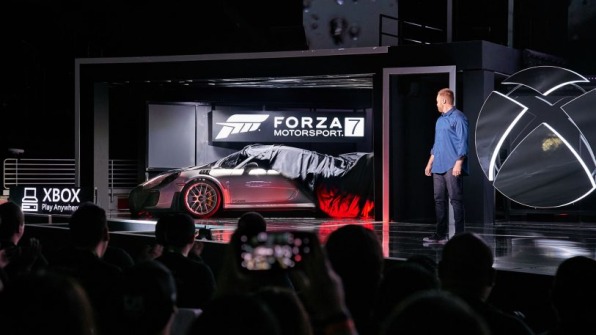
Complex Dynamics
Turn 10’s interest in keeping secrets is entwined with how Forza works. When Microsoft greenlit the first game in the series back in 2002, the idea was to avoid relying on subjective experience to bring cars into the game, and instead use formulas based on real-world vehicle data, which cover everything from aerodynamics to suspension to tire compounds. Game consoles aren’t powerful enough to ingest all this information on their own, so Turn 10 created a system to simulate each car on a server, which would then abstract the data into a set of characteristics that can run offline on less powerful machines. Greenawalt calls this the “simulation behind the simulation.”
“By being able to take raw data, we put the pressure on the researchers, and put the pressure on the manufacturers, rather than putting the pressure on game designers to try and make the car feel right,” Greenawalt says. “It feels right because the physics are right.”
Early on, Turn 10 worked with small number of automotive partners for data, but otherwise had to do much of the research itself, consulting experts and taking cars apart to see how they worked. (The studio even tapped Microsoft’s research arm to do some of the heavy lifting.) But as Turn 10 has pursued ever-more realistic simulations, the studio has convinced auto makers to provide more of their own data, including sensitive details used by their race teams. Because this information exists only on Forza’s servers, not inside the game itself, auto makers don’t have to worry about rivals reverse-engineering the game to learn their secrets.
“We’re able to get data that, honestly, they don’t give to anybody, what they consider competitive data,” Greenawalt says. “For example, on a race team, they don’t want to give their complex fluid dynamics, their aerodynamic data, to anybody. That is considered a competitive advantage to how they make their cars.”
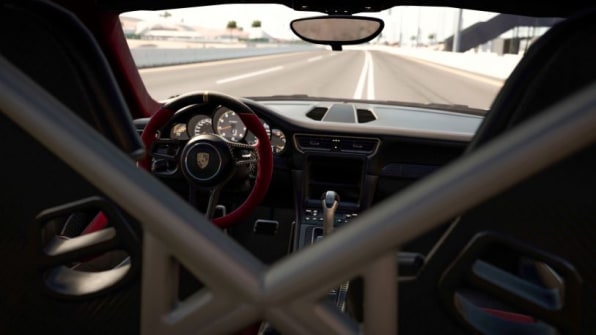
The allure of video games as a marketing tool helps motivate auto makers to participate. Under a straight-up licensing deal, auto makers typically don’t provide all the data that Turn 10 needs, Greenawalt says. But as the studio has gotten closer with auto makers–promoting one another through trade shows, social media, advertisements, and e-sports events–the data tends to follow.
“Everything has moved up the chain,” Greenawalt says. “A lot of relationships that used to be licensing relationships have become marketing relationships, and once they become a marketing relationship, they are actually encouraged and enthusiastic as an internal organization to give us as much data as we ask for, because they want their cars to be represented as accurately as possible.”
Those relationships, in turn, can lead to even deeper partnerships which yield bigger secrets. When Ford revealed a new GT supercar at the Detroit Auto Show in January 2015, for instance, Microsoft simultaneously announced it as the cover car for Forza Motorsport 6. For that project, Ford allowed Turn 10 into a secret design bunker at the auto maker’s product development center in Dearborn, Michigan, where the studio learned about the GT even before some Ford executives did.
Henry Ford III, the global marketing manager for Ford Performance, says the company decided to give Turn 10 access because of how the studio had dealt with other confidential material, including computer-assisted design (CAD) data that the auto maker would share before announcing new vehicles.
“They had kept some smaller secrets in the past, and they had done that well, so we took a leap of faith that they would hold onto this much larger secret, and they did, and it turned out great,” says Ford, the great-great grandson of the Henry who founded Ford.
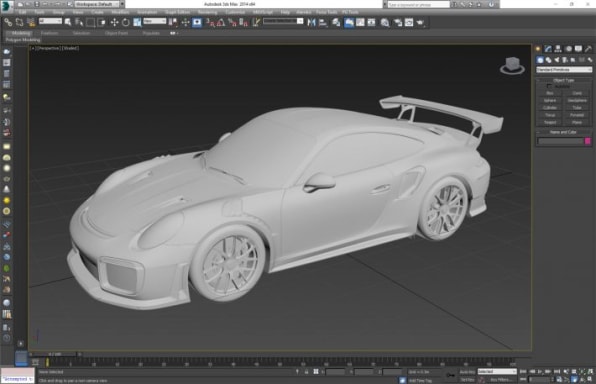
“Cloak And Dagger”
Porsche decided to take a similar leap for the 911 GT2 RS, employing several security measures to keep the car under wraps.
To begin digitizing a car, Turn 10 needs photos of both the interior and exterior at every conceivable angle. So in December, the studio sent a reference team to South Africa, where Porsche was conducting stress tests in a wide-open desert. Although no one could be seen for miles, Porsche kept the car under cover for most of the time, and would occasionally interrupt Turn 10’s photographer to cover the car back up, says Gabe Garcia, the studio’s art director.
“The reason they were doing it was, with that wide visibility, they were looking for drones,” Garcia says. “Believe it or not, people were flying drones to try to get spy shots of the car.”
Meanwhile, Porsche’s IT department made sure that Turn 10 was properly securing the car’s digital images and CAD data. When Porsche had new information to share, the company would send a password-protected link to download a file, which itself was locked behind a separate password. To avoid creating a paper trail, Porsche would then provide the file’s password by phone. For artwork, only Garcia and his top associate were allowed to see the results.
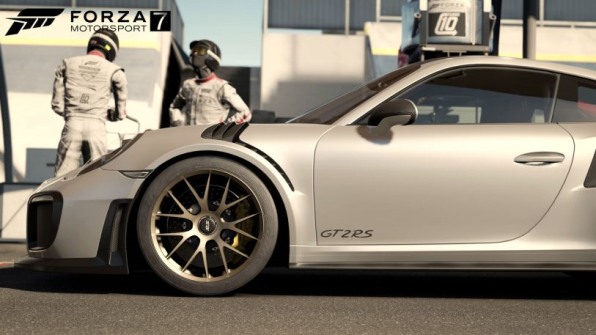
“It was like . . . ‘Hey, be at the bridge at midnight, no cops,’” Garcia says. “It was cloak and dagger, but they were very, very protective of this stuff.”
These weren’t onetime occurrences, either. Because Porsche was still developing the car while Turn 10 was building it into the game, the studio often had to make small adjustments in lockstep with the auto maker. Only a handful of senior Turn10 employees knew the GT2 existed, making the process even more time consuming.
“It was a little tricky to work around some of that,” Wendl says. “But we were very motivated to keep this a secret, so the world be surprised by it at E3, along with our game.”
The reveal at E3 itself also required extreme confidentiality. At the time, Porsche had only built three GT2s, two of which it had reserved for testing purposes. As Porsche moved its sole presentation car through USC’s Galen Center, the company’s internal security team had to kick people out of rooms so that no one who didn’t already know about the GT2 RS could get close to it. Even Microsoft’s event teleprompter avoided mentioning the GT2 RS by name, instead using the codename “Raymond,” which Turn 10 had designated for the car throughout the project.
Porsche and Turn10 managed to keep the secret the entire time. But Porsche’s Sebastian Hornung won’t say what would have happened if they’d failed.
“That’s a good question, and I believe we can’t answer that because it didn’t happen,” he says. “We didn’t have a backup plan for that.”
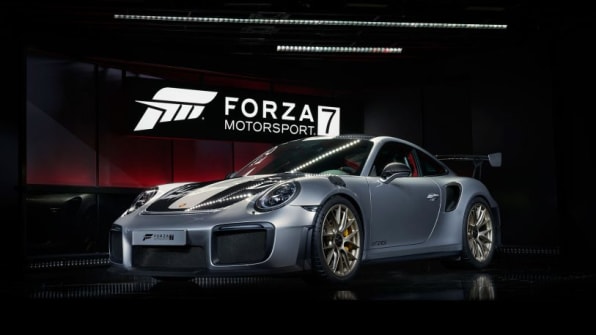
The Result
Hornung says Porsche was happy with how the announcement went, citing an “unbelievable” number of likes, shares, and other online activity around the reveal, and high praise from those within Porsche’s network.
But aside from just being a slick act of PR unto itself, the reveal is likely to have more ripple effects for Turn 10 and racing games in general. Turn 10’s John Wendl says this type of partnership sends a signal to other automakers, who might want to work with Forza or another racing game on similar activities in the future. That means fewer straight-up licensing deals, and more close partnerships, which in Forza’s case also translate to more accurate simulations.
“Having activations like that evolves people’s thinking, and it moves a little bit quicker when they see what’s possible,” he says.
Looking back, Turn 10’s Dan Greenawalt suspects that the E3 audience understood the implications of what they were seeing—or at the very least was struck by the beauty of the car that had suddenly appeared on stage. Either way, his brief insecurity about announcing the Porsche 911 GT2 RS turned out to be misguided.
“When I announced the car, and they turned it around and pulled back the silk, I felt the oxygen pulled away from me as the crowd kind of did a unified gasp,” he says. “It was the craziest thing. I even get goosebumps thinking about it now.”
Source: Fast Company




Sorry, the comment form is closed at this time.